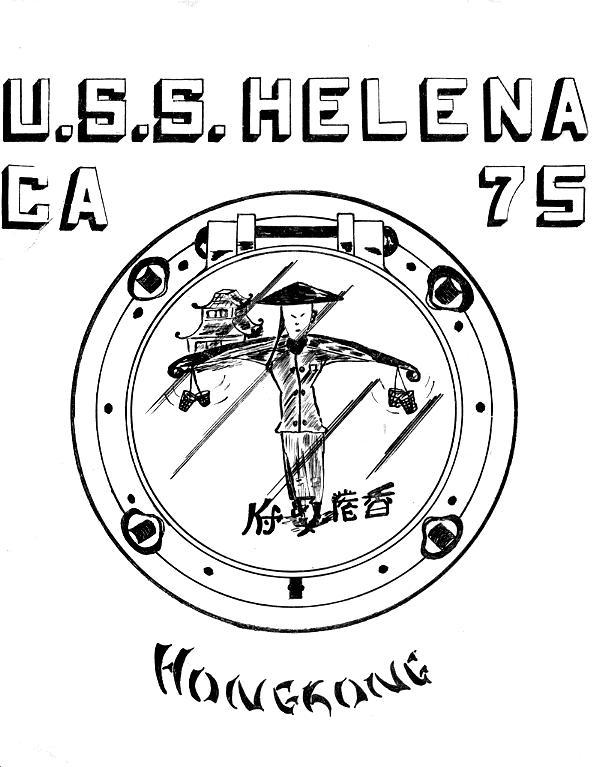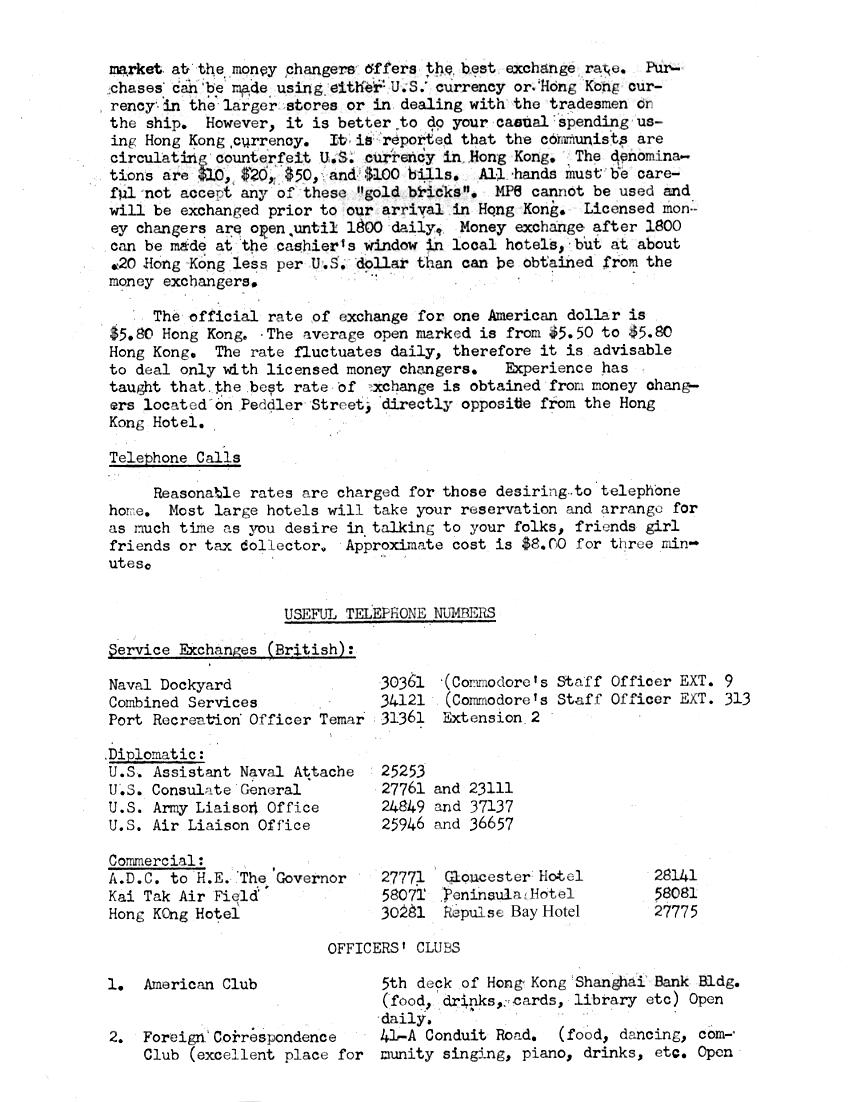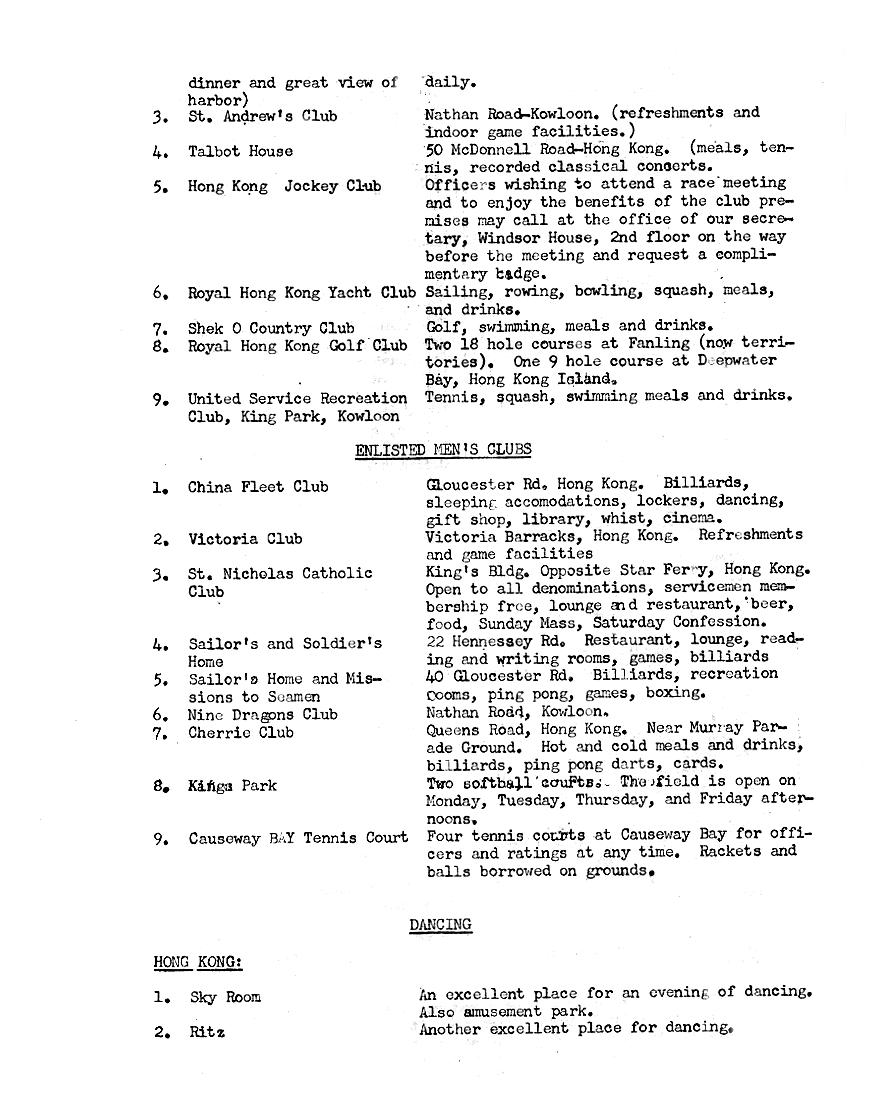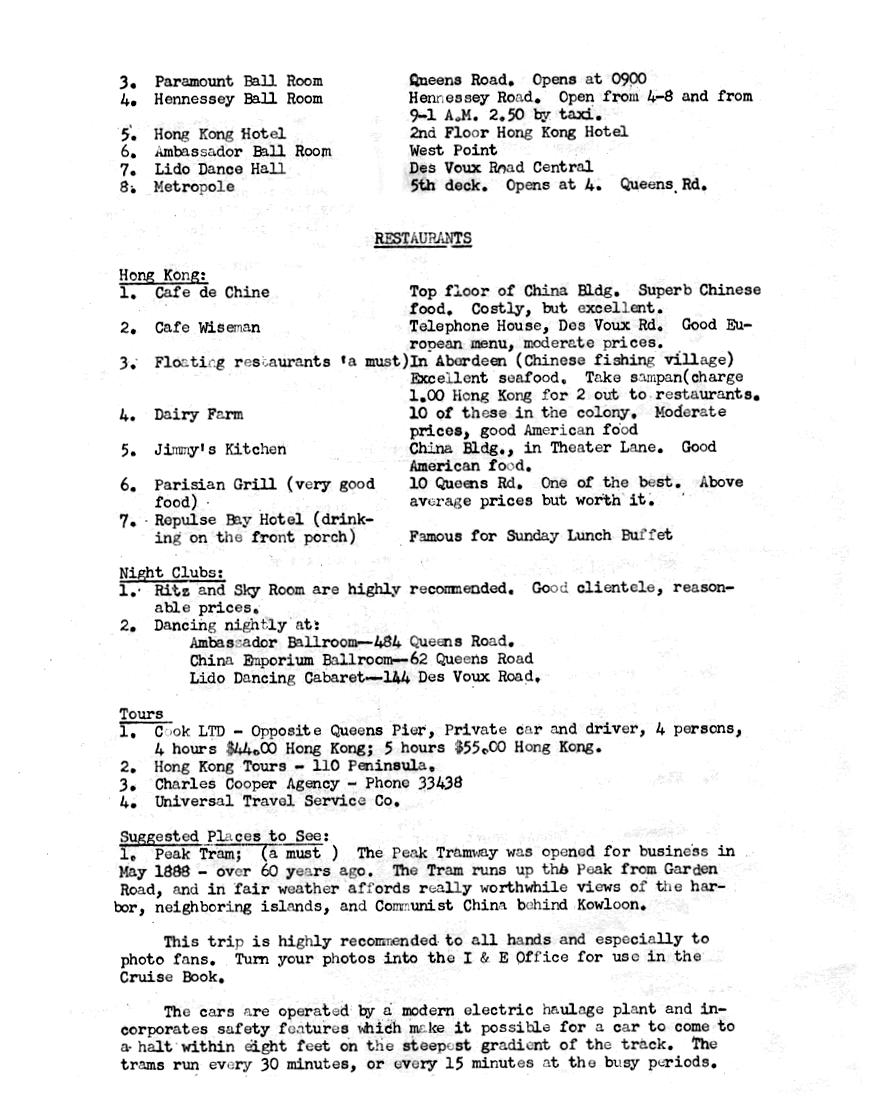The pamphlet measures 8" X 10.5" and has 17 un-numbered pages.
Pages 1 through 10

Front Cover
INTRODUCTION
"join the Navy and see the world" is probably the best known of all the Navy's famous sayings and in line with the idea contained therein the Helena will next show to its officers and men the fabulous city of HONK KONG. To the majority of you HONG KONG is probably nothing more than a name in the history of World War II or else the title of a song, and so with this in mind we arc presenting a pamphlet giving you information about what is perhaps the most interesting port we will visit during this cruise. It is our hope that this pamphlet will give you the opportunity to derive the maximum enjoyment and benefit from your stay in the Crown Colony of Hong Kong.
It should be made clean from the outset that you will be faced with a unique situation. Hong Kong today is a haven for hundreds of thousands of refugees from Communist held China. Since the victory of Communist forces on the Chinese mainland, the population of Hong Kong has skyrocketted from 800,000 to 2,000,000. Another uncommon feature is that while the overwhelming majority of the population is Chinese the government is under the control of the British. The port itself is used extensively by British warships. Thus you will be seeing and associating with a great many British Naval personnel. Remember that naval customs and courtesies are practical universal, and act accordingly.
Here, as in all foreign ports, you will be a gueet. The impression you make on your British hosts is an important one. If this impression is a good one you will be rewarded by having an enjoyable and constructive holiday; your host will welcome you warmly and do his best to entertain you. If this impression is a poor one you will probably have a hard time enjoying yourself, and might well end up in a lot of trouble; your host will frown upon you, and will be glad when you leave. Remember also, that the impression that you leave will determine the impression that will await your fellow sailors on other ships. The impression that awaits you is good let's keep it that way. Don't get the idea that creating a good impression is in any way difficul. Just act according to the standards you've been brought up to believe in, and don't do anything or say anything you wouldn't do or say in your own home town. You will find that the British are extraordinarily polite and solicitous hosts, and that they will do everything possible to make your visit to Hong Kong a pleasant one. You only have to accept their hospitality, in a graceful and appreciative way. Letts everyone go out and have a good time.
Page 1
HISTORY
The area which now forms the Crown Colony of Hong Kong is first mentioned in Chinese histories as part of the territories of the Maan tribes, who then inhabited the greater part of China south of the River Yangtse.
The Arabs were already known in Canton in the VII century A.D., but
European intercourse with China dates from the XVI century when expeditions from the maritime states of - -Portugal, Spain, the Netherlands and England—penetrated into Far Eastern waters in the hope of establishing a direct trade by sea with the Moluccas or Spice Islands.
Two attempts had been made to establish normal official relations with China, by Lord McCartney in 1793 and by Lord Amherst in 1816; but these were rebuffed by the Manchu Court at Peking.
On January 20th 1841, Captain Elliot, as Chief Superintendent of Trade, announced "the conclusion of preliminary arrangements between the Commissioner and himself involving the cession of the islands and harbor of Hong Kong to the British Crown". Hong Kong Island was then inhabited by a few fishermen, stonecutters, and farmers and provided a notorious retreat for smugglers and pirates. He declared further that "Her Majesty's Government has sought for no privilege in China exclusively for the advantage of British ships and merchants" and he assured "the protection of the British flag to the subjects, citizens, and ships of foreign powers that may resort to Her Majesty's Possession".
Early accounts of life Hong Kong show that the early colonists had many obstacles to overcome. The new settlement was ravaged by fires, the houses leveled by typhoons, and the population decimated by fevers; yet the administration did not lose heart. Encouragement was given to merchants to build their business premises and residences, roads were laid down, and a town planning committee set to work. Markets and hospitals were built, churches for several denominations were provided, and schools established, all within the space of the first three years.
At the first census, the population of Hong Kong did not exceed 3,650 villagers and fishermen living in some 20 villages and hamlets, including Stanley, Aberdeen, and Wongneichong, with about 2000 Chinese living in boats in the harbor. Encouraged by prospects of work, Chinese laborers flocked into Hong Kong, and by April the population reached 19,000. The establishment of Shipbuilding yards eventually to grow into a major industry, dates from the Colony's earliest days.
After Japan invaded China in 1937 the Colony became a refugee for many Chinese and the population grew to over one and a half million. Until the fall of Canton at the end of 1938 valuable supplies were able to reach China through HongKong. With the outbreak of war in Europe in September 1939 the position of the colony became precarious, and on December 8th 1941 the blow fell. Powerful units of the Japanese Army,, supported by the Japanese Air Force based in Canton, struck at the Colony. The first attempt of the Japanese to land on Hong Kong Island was repulsed on the night of the 15th-16th, but a second attempt on the night of the 18th--19th could not be held. After some bloody fighting on the
Page 2
Island, the Colony was surrendered to the Japanese forces on Chrismas Day. The isolated brigade Stanley peninsula held out for further days before capitulating on superior's orders. Hong Kong remained in Japanese hands for over three years and the population fell from more than one and a half million to a third of that number.
The Colony was liberated when units of the British Pacific Fleet entered the harbor on August 30th, 1945, about two weeks after the capitulation of Japan. A brief period of military administration was followed by the re-establishment of civil government on May 1st 1946,
GEOGRAPHY
Hong Kong lies just within the tropics, on the south-eastern coast, of the Chinese,Province of Kwangtung, and east of the Pearl River estuary. The Colony includes Hong Kong Island (32 square miles), on which is situated the capital city of Victoria, the ceded territory of Kowloon (3 ¼ square miles), Stonecutters Island (¼ square mile) and the New Terriories which consist of the remainder of the mountainous peninsula of Kowloon together with numerous islands (355 square miles) leased from China on 1 July 898 for 99 years. The total area of the. colony is thus roughly square miles, a large proportion, of which is steep and unproductive hillside.
Hong Kong Islnd is eleven miles long from east to west and varies in width from two to five miles. It rises steeply from the northern shore to a range of treeless hills of volcanic rock of which. the highest hill is Victoria Peak (1809 feet) near the western end. Between these hills and the harbor' lies the city of Victoria. The oldest part of the urban area ran up the steep hillside for hundreds of yards in narrow stepped streets and terraces, but the modern town stands mostly on a of reclaimed land averaging 220-400 yards wide which extends 9 miles along the southern shore the harbor from Sulphur Channel to Dyemun Pass.
Between the Island and the mainland of Kowloon lies the harbor, a natural and almost landlocked anchorage about 17 square miles in area, and a width varying from one to three miles. This harbor, lying midway between the main ports of Haiphong in Indo-China and Shanghai at the mouth of the Yangtse River, has become the gateway to South China and has grown to be one of the greatest seaports in the world.
The town of Kowloon contains the Colony's main industrial area, one of the two principal commercial dockyards wharves for ocean-going ships, and a large residential suburb. Its population in 1941 threatened to overtake that of Victoria; the terminus of the Kowloon-Canton Railway, which connects at Canton with the network of the Chinese railways, is at the extreme southern tip of the peninsula. The UNICORN range of hills, even more precipitous though less high than those of the island, forms a barrier between Kowloon and the remainder of th Kowloon peninsula.
A large part of the New Territories, both islands and mainland, is
steep and barren. Before the war considerable areas were forested, but one of the unfortunate results of the occupation of the Colony by the Japanese was the felling of the vast majority of the trees for firewood, with the consequence that now only a few isolated woods remain, principally in
Page 3
the vicinity of villages. Intricate terracing brings the maximum of land under cultivation down to the bare minimum needed to produce enough to live on. The Chinese farmers, though ready to adopt any modern methods which are suited to local conditions and whose values has been demonstrated to them by practical tests, find in fact that there are few directions in which their traditional methods can be improved upon.
CLIMATE
The climate is sub—tropical and is governed to a large extent by the monsoons, the winter being normally and dry and the summer hot and humid. The early winter is the most pleasant time of the year, the weather being generally and the atmosphere dry. After the New Year, the sky is more clouded, though rainfall remains slight; in March and April long spells of dull overcast weather may occur. From May until September the air reaching Hong Kong has generally travelled from warm tropical to the east and south of the Colony; the weather is persistently hot humid, and often cloudy and showery with occasional thunderstorms. The summer is the rainy season, three-quarters of the average annual rainfall of 84.26inches falling during the period May to September.
Hong Kong is liable to be affected by. typhoons from July to October, although they are sometimes experienced before and after this period. Spells of bad weather, heavy rain and strong winds normally occur several times in each summer owing the passage of typhoons or tropical storms at varying distances from the Colony.
Dangerous gusts are always a possibility during the winter months when the wind has a northerly direction, and on this occasion the maximum gust velocity recorded at Kai Tak was actually higher than any gust due to typhoon winds during the past three years,
HEALTH AND SANITATION
General
Sanitation in Hong Kong is below U.S. public health standards, but is higher than in most oriental cities.
There are several reliable European and American eating establishments in Hong Kong where it is safe to eat. A number of these are listed in later pages of this pamphlet. Fresh vegetables and fruits should not be eaten elsewhere because night soil is used as fertilizer.
Diseases
Venereal diseases are very prevalent. The venereal disease rite is extremely high among prostitutes and street walkers. Gonorrhea and Chaneroid are the most frequent venereal diseases encountered, but cases of Syphilis, Lymphogranulema Venereum and Granuloma Inguinals are not uncommon. Abstinence is the only safe means of protection.
Tuberculosis is very prevalent in the civilian population. Because of crowded conditions and lack of adequate medical facilities for these cases, the mortality rate is high. Amoebic and Bacillary dysentary are common.
Page 4
Whisky and spirits,
Canadian and Scotch whisky may be obtained, and may be considered to be clean. Very little local whiskey is produced, but should not be consumed. European beer and the well known brands of locally distilled beer are believed to be clean.
SECURITY
Hong Kong is just a short boat ride from the Communist—held main—land of China. Rest assured that there will be plenty of spies around, spies of all colors, sizes, and descriptions. Not all of these are men. Some of the most deadly and efficient Communist agents are shapely, attractive members of the feminine sex.. They may seem only innocently curious, in
your doings, how your ship operates, what kind of weapons it uses, where it came from, where it is going etc. DON'T TELL THEM! DON'T TELL ANYONE! These little hints to information may seem unimportant to you, but they can supply valuable intelligence to your enemies. Intelligence that can be used to send you to that well—known locker run by Davy Jones, or to kill your countrymen on the battlefields.
So keep all your "Mess Deck Intelligence" to yourself. The old cliche "A slip of the lip may Sink a Ship" wontt sound near so trite if it,happens to be your lip that slips, and your ship that is sunk.
ETIQUETTE AND CONDUCT ASHORE
The visiting units of the U.S. Navy have been received by the British people in a most cordial and courteous manner. Officials, both military and civil, have done a number of things for our welfare and have cooperated with us in every possible way.
Do not be impolite, The use of unflattering nicknames or slang expressions is to be avoided because in almost every gathering there may be a Chinese who understands English and who may be offended because he does not understand
your use of the expression. A ready smile, a friendly nod backed up by good manners will make a favorable impression in any city in the world.
Above all avoid pugilistic tendencies. Such madness can lead only to assault and battery charges and thence to real trouble. Further, it seems reasonable that as guests in Hong Kong we should not threaten or strike our hosts, the British. Such incidents always make a very bad impression and can lead to serious consequences. At the same time we need suffer no indignities. Legitimate complaints should be made to the Senior Shore Patrol Officer,
A few DO's:
(1) Conduct yourself as a gentlemen should,
(2) Remain in complete clean, and neat uniform.
(3) Pay your bills if incurred.
(4) Treat with due respect all the people you come with.
Page 5
GENERAL INFORMATION
The information contained in the following paragraphs. in the latest available. You may find that a few of the statements made are no longer accurate when you actually, arrive in Hong Kong. The greatest part of what you will find in those pages, however, will still apply.
All liberty landings in Hong Kong are commercial landings, however, liberty boats will make the Fleet Landing on the Hong Kong side only. Liberty boats will not lie alongside for extended periods of tine. They will remain alongside only long enough to embark or disembark passengers. Prescribed landings are:
(1) On Hong Kong side:
Official calls . . . . . . . . . . . . . . . . Flagstaff steps in loyal Navy Dockyard.
Officers Landing . . . . . . . . . . . . .Queens Pier, at Monument Square.
Fleet Landing . . . . . . . . . . . . . . . Blakes Pier, adjacent to Star Ferry Slip.
Shore Patrol Landing . . . . . . . . . Tamar Steps, H.M.S. Tamar (Wellington Barracks)
Out of Bounds Area
The district bounded by the junction of Hennessey Road and Queen's Road, east, along Hennessey and Johnston's Roads to junction with Kennedy Road; along Kennedy Road to the Eastern boundary of Victoria Barracks north to junction of Hennessey and Queen's Roads. The squatters shacks and area enclosed by Blue Pool's Road and Tsum
Wum Street near Happy Valley. Kowloon is out of bounds to all enlisted personnel. Officers may visit in Kowloon only if they are attired in Civilian Clothes,
Transportation
Reports of the unreliability of certain. taxi drivers indicate it is not always safe to hire a taxi unless two or more persons are in the group. The use of rickshaws at no time is recommended. Tram and bus schedules are available in the Hong Kong directory.
Water taxis "walla-wallas" may be obtained at any of the commercial piers on either the Hong Kong or Kowloon sides of the harbor. They will also provide transportation from ships to the piers if given a signal to come alongside. They give excellent end dependable service and may be employed for $4.00 Hong Kong for one to six passengers one way, either pier to ship or ship to pier.
TAXIS
Taxis are plentiful and park chiefly near the Star Ferry landings both in Victoria end Kowloon. Some taxi drivers do not speak or understand English and may take you miles out of your way in the wrong direction. This may sometimes be on purpose to collect a larger taxi fare. Keep in mind the general area. you wish to go and
Page 6
don't lot yourself be taken in by a fast shuffle. Refuse to pay the driver who failed to deliver you to your destination. Only by this action can you prevent Americans in general from being cataloged as
"suckers".
Official fares are $1.50 Hong Kong for the 1st mile and 25 cents Hong Kong for each additional quarter mile. A 2 mile trip in a small
taxi should not cost over $1.80 Hong Kong which is approximately 30 cents in American money.
Don't haggle with the taxi driver. If the taxi doesn't have a
meter, pay for the distance you travelled and shove off. In the long run it is best to take a taxi that has a meter and an English speaking driver. For groups riding together, divide the fare equally as registered on the meter. The meter fare is not each passengers fare.
CAUTION
It is not advisable to use a rickshaw, especially alone. Should
the rickshaw boy take a short cut through a deserted street he can easily knock you out by simply tossing his arms up which will raise the rickshaw handlebars and catapult you backwards onto the pavement. Chances are your wallet contains more than his rickshaw is worth.
Pickpockets
Stealing is a major problem in Hong Kong. With the influx of many refugees and homeless the rate of stealing, has increased. The pickpockets are masters of this dubious art. With a razor blade they can easily remove your billfold without your being aware of it. Be on the alert. Don't place your billfold so the pick pocket can slip it off you unnoticed. There are faster ways to lose your honey, but none more unhappy than to have your bill fold "lifted".
Upon leaving the area, if
ships whose personnel have reported pickpocket losses will send to the Naval Attache, U S.. Consulate, Hong Kong via Station Ship, a description or identification of article lost, and a report will he made to return identifiable item to their rightful owners, since wallets are often dropped into mailbox after valuables have been removed by pickpockets. A word to the wise should be sufficient.
Telegrams
The following places will accept telegrams. Victoria: Union Building corner Connaught Road and Pedder Street., Cable Office
Connaught Road. RATES to U.S.: night letters (25 words) 10.00
Hong Kong each additional word .40 Hong Kong. Standard telegrams per word $1.20 Hong Kong.
Money Exchange
The unit of currency is the Hong Kong dollar, which at present exchange rates is about $6.00 Hong Kong for $1,00 U.S. The open
Page 7

Page 8

Page 9

Page 10



